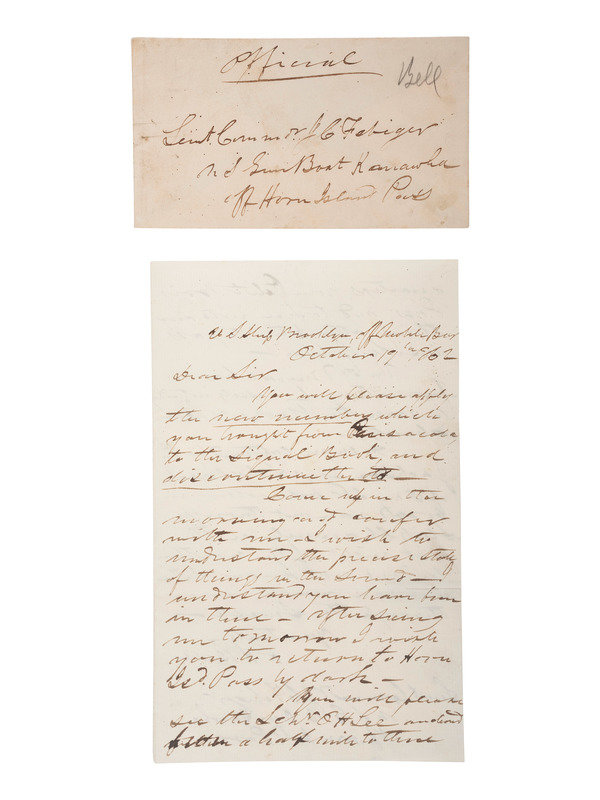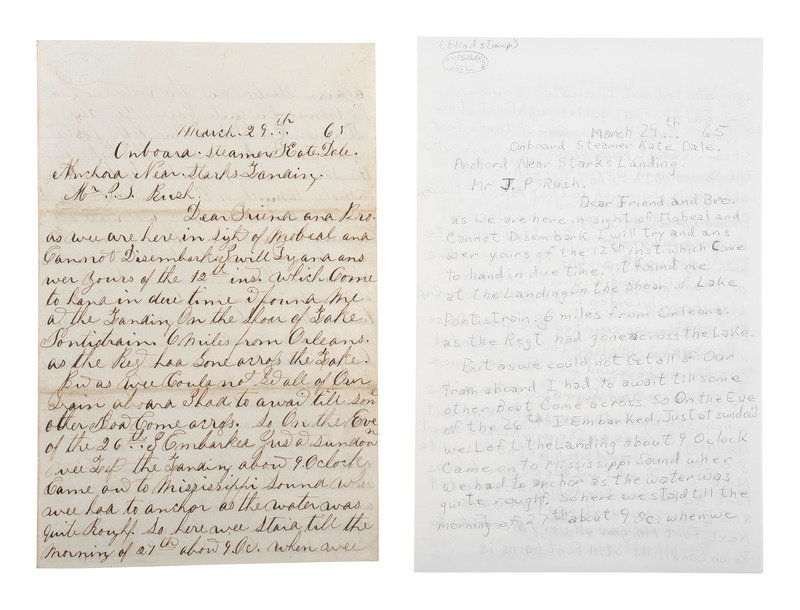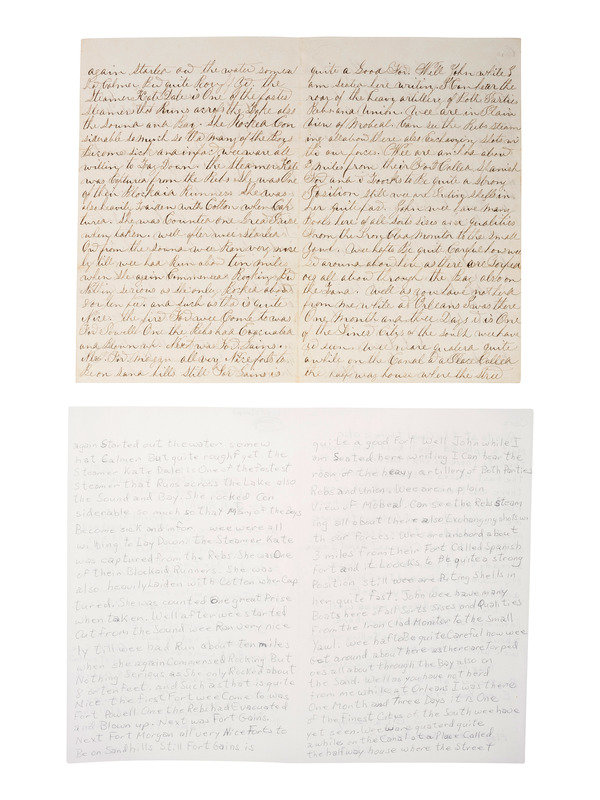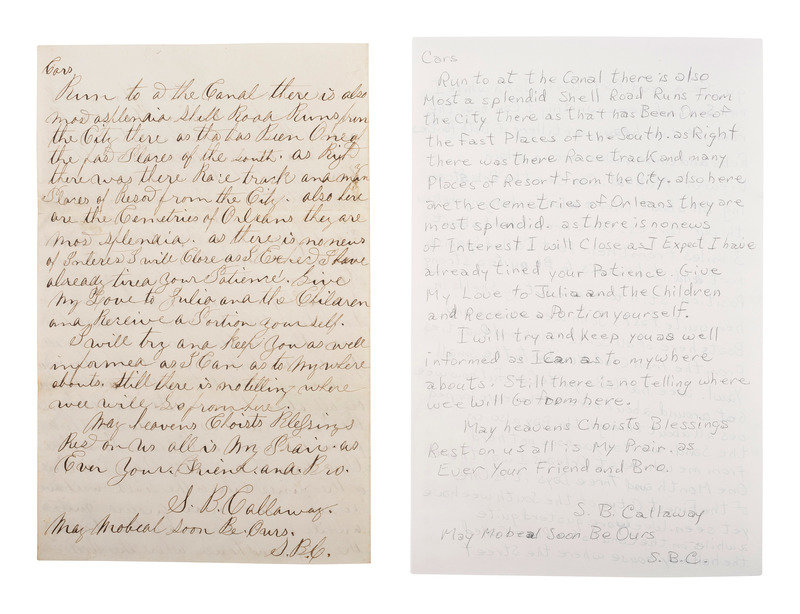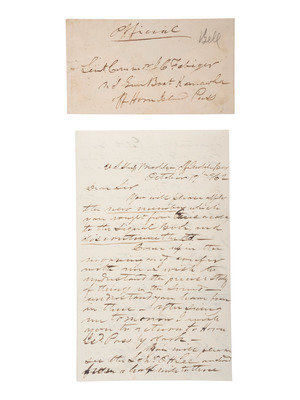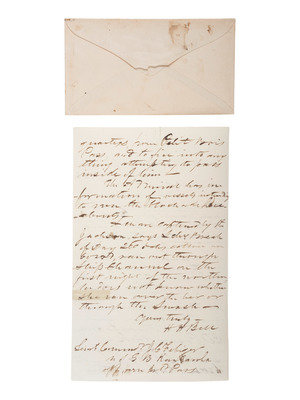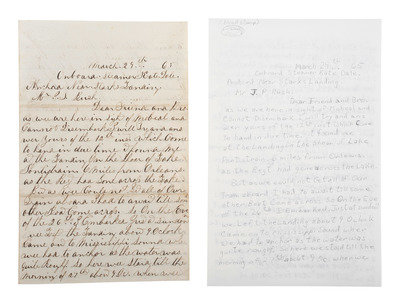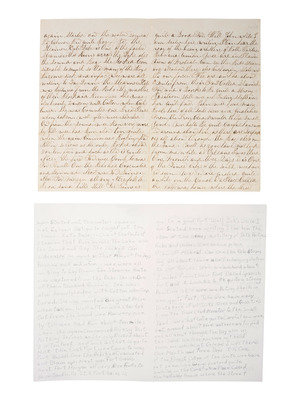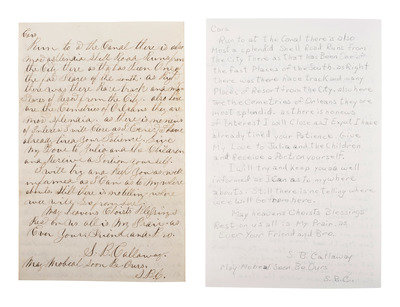Lot 638
[CIVIL WAR - NAVY]. A group of 2 letters with Mobile Bay interest, including the Battle of Spanish Fort, comprising:
Sale 1047 - American Historical Ephemera & Photography
Lots Open
Jun 17, 2022
Lots Close
Jun 28, 2022
Timed Online / Cincinnati
Own a similar item?
Estimate
$250 -
350
Price Realized
$531
Sold prices are inclusive of Buyer’s Premium
Lot Description
[CIVIL WAR - NAVY]. A group of 2 letters with Mobile Bay interest, including the Battle of Spanish Fort, comprising:
CALLOWAY, S. B. Autograph letter signed ("S.B. Callaway") as sailor serving on board the steamer Kate Dale, anchored near Starks Landing, Alabama, “in sight of Mobeal,” to “Mr. J.[?] Bush, 29 March 1865. 4 pp, 8vo (creasing at folds). Relates events in the area of Mobile Bay two weeks before the surrender of the City of Mobile. “The Steamer Kate Dale is one of the fastest steamers that runs across the Lake also the Sound and Bay . . . . was captured from the Rebs. She was one of their Blockaid Runners. She was also heavily laden with Cotton when captured. She was counted one great Prise when taken. The first fort we come to was Fort Powell. One of the Rebs had evacuated and blown up. Next was Fort Gains. Next Fort Morgan all very nice forts to be on Sand hills. . . . while I am seated here writing I can hear the roar of the heavy artillery of Both Parties Rebs and Union. We are in plain view of Mobeal. Can see the Rebs steaming all about there also Exchanging shot with our forces. We are anchored about 3 miles from their fort called Spanish Fort and it looks to be quite a strong position[.] still wee are putting shells in her quite fast. . . . Wee half to be quite careful how wee get around about here as there are torpedoes all about through the Bay also on the sand.” Then he describes an earlier stay in New Orleans in interesting detail. His postscript: “May Mobeal Soon Be Ours.” His wish came true: Mobile surrendered on April 12.
The Kate Dale had been built expressly to run Farragut’s blockade of Mobile Bay early in the war. It had been quite successful in contributing to the trade between the Confederacy and the Islands, especially Cuba, that provided much needed revenue for the war effort. The Battle of Spanish Fort began two days before this letter was written and yielded a Union victory on April 8. Fort Blakely fell on April 9. An excellent eye-witness account.
[With:] BELL, H.[enry] H. Autograph letter signed ("H.H. Bell"), from aboard the Brooklyn in Mobile Bay, to Lt. Comm J.[ohn] C.[arson] Febiger aboard the Kanawha off Horn Island Pass, 19 October 1862. 2pp, 8vo (scattered ink marks, adhesive along folds). Bell instructs him to “apply the new numbers which you brought from Pensacola to the Signal Book, and discontinue the old.” Febiger is instructed to see Bell in the morning—“I wish to understand the precise state of things in the Sound”—and then to return to Horn Island Pass. "You will please see the Schr. O.H. Lee anchored a half mile to three quarters, from Petit Bois Pass, and to fire into anything attempting to pass inside of him. / The Admiral has information of vessels intending to pass the blockade hereabouts. / A seaman captured by the Jackson, says Schr. Break of Day 260 bales of cotton onboard, ran out through Ship Channel on the first night of the [?]. He does not know whether she ran over the bar or through the Smash.” Original addressed envelope included. Febiger was commissioned Commander on 11 August 1862 and assigned to the Kanawha, Western Blockading Squadron, and worked there with great effect, capturing four blockade runners on a single day, 11 October 1862, one week before this letter was written. Febiger eventually achieved the rank of Rear Admiral. Captain Henry H. Bell assumed command of the Brooklyn on 2 July 1862. On October 6, the Brooklyn was sent to blockade duty off Mobile Bay and remained there for the rest of the year.
The Richard B. Cohen Civil War Collection
Condition Report
Contact Information
Auction Specialist
